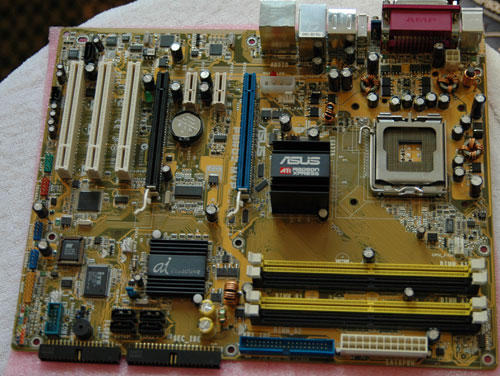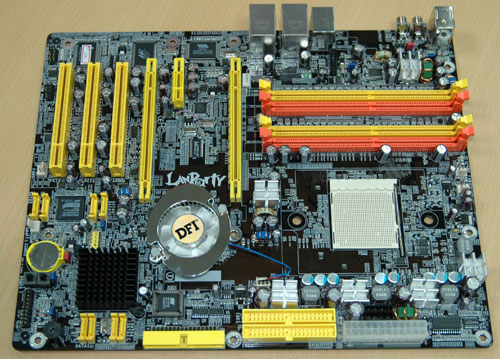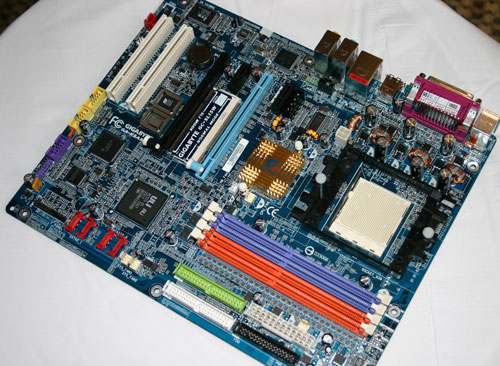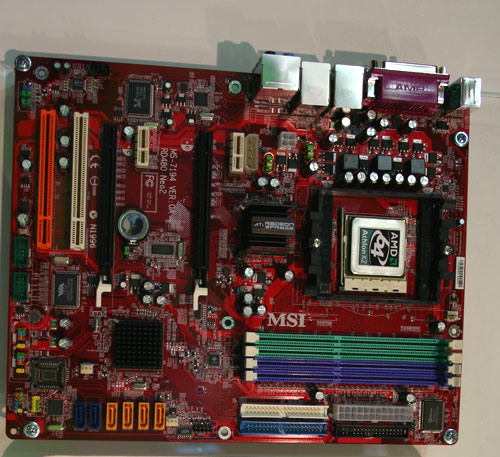Computex 2005 Day 2 - ULi's new Athlon 64 Chipset, G70, CrossFire & more
by Anand Lal Shimpi on June 1, 2005 1:57 AM EST- Posted in
- Trade Shows
ATI CrossFire Motherboards
Although most of the CrossFire demos running at the show were running on ATI Reference Boards, other manufacturers did have their boards on display.
ASUS is only making an Intel CrossFire board, pictured below:

DFI has a particularly impressive AMD CrossFire board; even ATI was surprised that they had it up and running with so little time with the chipset. Note the lack of any legacy Parallel or Serial ports:

Although it was covered by a heatsink, DFI will try to use ATI's South Bridge for their motherboard because of pressure from ATI.
Gigabyte's AMD CrossFire board still uses a selector card like the nForce4 SLI boards in order to cut costs:

Note the use of the ULi South Bridge on the Gigabyte board above.
Last, but not least, MSI had their AMD based CrossFire board on display as well:











53 Comments
View All Comments
Tanstafl - Tuesday, June 7, 2005 - link
#52, the reason they chose to use a PCI slot is most likely because that allows them to use standby power to retain the content of the RAM drive. If you check what's been written about the Gigabyte RAM disk card you will find that the battery is only used when the machine is unplugged, or when there is a power outage.erwos - Friday, June 3, 2005 - link
"#50, yeah there is another purpose other than power. The PCI slot holds the card in place so it doesn't rock around inside your tower. :)"Again, you don't need a PCI slot for that. A mounting bracket would solve that just fine, and possibly even give me room for two in a single 5.25 bay. It's solid state - the thing isn't going to move.
mlittl3 - Thursday, June 2, 2005 - link
#50, yeah there is another purpose other than power. The PCI slot holds the card in place so it doesn't rock around inside your tower. :)erwos - Thursday, June 2, 2005 - link
My _theory_ is that the PCI bus is used for something other than just power. Maybe some kind of configuration and/or debugging. I find it tough to believe they made this thing use PCI for power alone, because a simple 4-pin would have solved that pretty easily.-Erwos
KayKay - Thursday, June 2, 2005 - link
Wow, this was an excellent article, one of the best i've seen to date.AGP and PCI-E on the same board, don't see much of that, but im sure people out there would appreciate it if it was widely available
nserra - Thursday, June 2, 2005 - link
#40 What are you talking about I have been installing PC's with ASrock boards (K8 Combo-Z and K8Upgrade-1689) and all super stable and fast (boot time records!!!). I have to say that these are all much faster than the asus boards that I was installing (K8V SE, ...)You must have been unlucky, and don’t forget one thing if mobo makers and bios makers put the same affords they do on intel chipsets, I doubt that Uli and Sis looked so bad...
jiulemoigt - Thursday, June 2, 2005 - link
this is wrong pikhttp://images.anandtech.com/reviews/tradeshows/200...
on p9
http://www.anandtech.com/tradeshows/showdoc.aspx?i...
there is three dead give aways one which i feel like
an idiot for missing is the VGA connector and the
others are the audio jacks are sperated in one pik but not in the cut away and it still supports two ethernet adapters which is also missing in the second pik.
Penth - Wednesday, June 1, 2005 - link
mosoon:You are right with your guess that even the newest and fastest SATA drives fail to max out a SATA I connection. I think my Raptor maxes out at about 70-something MB per second. Not even half the capability of the SATA interface.
I am supremely interested in this card, but I think if I was going to be paying that much per GB, I would wait for a SATA II connection, where the increase in bandwidth would be very apparent with 300MB/s sustained transfers.
monsoon - Wednesday, June 1, 2005 - link
MLITTL3 forgive my ignorance, but how does it come that data transfer through the SATA connector is faster when pumped by the i-RAM instead of a SATA HD ?i mean, ok, i understand HD access latency is lower, but shouldn't we already have the SATA BUS at its max if we buy some kick ass SATA HD ?
or is it that SATA HDs around ( including RAPTORS, etc.. ) come nowhere near the bandwidth possibility of the SATA bus ?
cordially,
JOHN
PS - please bear with my ignorance !!!
DanDaManJC - Wednesday, June 1, 2005 - link
hmmm that ULi mobo, well specifically their chip that allows both agp and pci-express looks awesome!I've been waiting around for a solution like that... now all I need is $500 for the rest of the pc... haha *sigh*